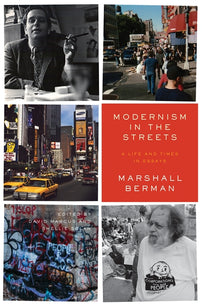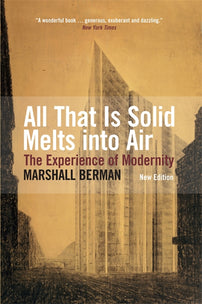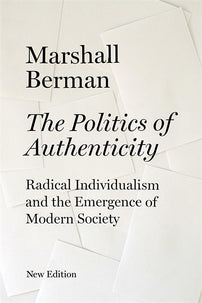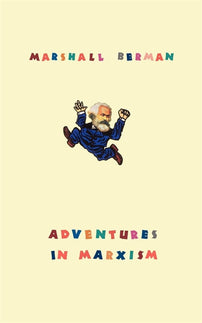A face in the crowd
Marshall Berman, the celebrated political philosopher and urbanist, died ten years ago this month. His deep commitment to a Marxist humanism, a 'Marxism with soul', has much still to teach us.

My favourite photo of Marshall Berman, who died ten years ago this month, is one taken in London in 1991. It captures a typical city street scene. On the left a woman with a shopping bag strides towards us, behind her a massed bunch of balloons of varying shapes and colours – dolphins, pandas, cars, love hearts – extend from an out-of-view street seller's hand. On the right another woman carries one child in a sling on her front and one on her back, a balloon in one hand, an ice cream in the other. The street in the background bustles with people. Among it all stands Berman, in t-shirt and jeans, blinded by the sun, a squint and a smile on his face. The photo is Berman all over: a figure often celebrated as one of the most influential urban theorists of his generation, himself a part of the everyday life of the city, a face in the crowd.
The subject of the photo – this is what I like about it most – isn't really Berman; it's the human energy and flow of the street, the very energy and flow that animated and infused so much of his thinking.
*
Berman's early work set the agenda for what was to come. Its primary aim was to supplement Marx's account of capitalist modernization as a world-historical process with an analysis of the psychological condition, and conditioning, of the individual in modern society. It was on the basis of this attempt to align the material and the existential, the political and the personal, that Berman turned to Montesquieu and Rousseau. Their shared approach to modern society – and prefiguration, Berman claimed, of what Marx later called self-alienation – is the focus of The Politics of Authenticity (1970), Berman's first book.
Here 'authenticity' broadly denotes the free development and uninhibited expression of the self. Berman takes the term from Heidegger and Sartre, but readily acknowledges his conceptual imprecision. 'My choice of the word was rather arbitrary', he admits at the start of the book; 'so many others might have done as well. "Identity", "autonomy", "individuality", "self-development", "self-realization", "your own thing": our vocabulary overflows with expressions which express a persistent and intense concern with being oneself'. The persistence and intensity of Berman's own concern with this notion of authenticity would propel his life's work. It's where it all begins and ends – his regulative ideal, his profession of faith.
What makes Montesquieu and Rousseau so incisive and appealing for Berman when approached from this perspective is the manner in which they illuminate 'the problem of the self': how might authentic self-realisation be achieved in a society that deliberately 'represses, alienates, divides, denies, destroys the self'? The solution, they suggest, lies in dialectics. We must, in Rousseau's words, 'draw from the evil itself the remedy that can cure it'. Indeed these eighteenth-century dialecticians reveal how 'even though everyone' – and by 'everyone' Berman means all classes of people – is 'conditioned by an alienated social system, this conditioning may include a capacity to criticize and transcend the system.'
[book-strip index="1"]
This basic insight will in many ways constitute the point of departure in Berman's most celebrated book, All That Is Solid Melts Into Air (1982), and its account of the dialectics of economic development and human development: the ever-present human possibilities that capitalist modernization simultaneously creates and destroys. It will likewise sustain his tireless insistence on ambiguity and contradiction, on the 'paradoxical unity' of beauty and horror, delight and misery, exhilaration and dread, as the essential experience of modernity. 'To be modern', Berman declares in the dazzling opening passage of All That Is Solid, 'is to find ourselves in an environment that promises us adventure, power, joy, growth, transformation of ourselves and the world – and, at the same time, that threatens to destroy everything we have, everything we know, everything we are.' Modern life feels at once thrilling and terrifying: the best of times, the worst of times.
Modernity, as Berman sees it, is as much an experience of space as it is of time. Indeed the city, though already a key theme in The Politics of Authenticity, came to preoccupy his later writings. What did cities mean to him? Why did they matter? On the whole, Berman is certainly not the sort of social theorist who drew blueprints for the future or prescribed a definitive set of political demands. 'We still dream of resolving our inner contradictions and living in a more integrated way', he writes. 'We know, as Marx did, that this can't happen without a radical transformation of our economy, state, and society; we also know that this can't work if it's imposed from above, but only if people come together freely to do it on their own.' What we mainly get, then, are fundamental premises, general ideals. City streets, by contrast, have a concrete role to play. The city provides the actual 'terrain' on which this ideal or 'dream' of personal authenticity and democratic community can materialise. This is where the promise of modernity can be fulfilled; this is the 'place where the self [can] feel at home'. In open public space 'people can actively engage the suffering of this world together and, as they do it, transform themselves into a public.' Here the possibilities are not only political but existential. The street can enable people to 'feel alive, more alive than they are supposed to be'. Berman believes in the city – and he wants us to believe in it, too.

New York City was Berman's home for almost all of his life. Born in the South Bronx in 1940, in the 1950s his family found themselves among the thousands of ordinary people displaced by the construction of Robert Moses' Cross-Bronx Expressway, the latest in a series of major public works that transformed the city over the course of forty years. Entire neighbourhoods like Berman's were flattened, communities condemned to obsolescence, in order to make way for the road and the grand vision of modern urban space that it embodied. 'I can remember standing above the construction site for the Cross-Bronx Expressway, weeping for my neighbourhood', he recalls in All That Is Solid, 'vowing remembrance and revenge, but also wrestling with some of the troubling ambiguities and contradictions that Moses' work expressed.' The devastation of the South Bronx, devastation seemingly carried out in the name of progress, renewal and reform ('values that we ourselves embraced'), was Berman's own personal 'tragedy of development'. It brought home to him how 'so often the price of ongoing and expanding modernity is the destruction not merely of "traditional" and "pre-modern" institutions and environments but – and here is the real tragedy – of everything most vital and beautiful in the modern world itself.' This brutal personal encounter with the post-war 'expressway world', and the feelings and ideas it generated in him, proved to be central to his intellectual formation. His 'quest for a core of meaning inside the ruins', as he later described it, is at the heart of All That Is Solid, and so much of his work beyond it.
Berman came of age politically in the 1960s as part of the generation who took to the streets across America in the struggles for civil rights and against the Vietnam War. Many hopes of far-reaching social transformation were of course soon dashed in the 1970s. But Berman held on (at times nostalgically, he himself admitted, though by no means uncritically) to the radicalism of the preceding decade and its original promises, defending and deepening the ideals of individual self-liberation and mass political participation as advanced by the Students for a Democratic Society (SDS) and the New Left more generally. Even as the emancipatory horizons of his youth appeared to recede in the 1980s and 1990s, his early political commitments, and his commitment to the street as the primary site and symbol of radical politics, continued to inflect his thinking and inspire his hope. 'I don't think I've grown old yet', he says in Adventures in Marxism (1999), 'but I've been through plenty, and through it all I've worked to keep Marxist humanism alive.'
French philosophy is particularly crucial to both the initial formulation and subsequent elaboration of this overall project. If Berman's early work explores the condition of self-alienation in modern society through a subtle and suggestive reading of Montesquieu and Rousseau, the latter remains a privileged interlocutor when it comes to understanding the contradictions of modern life. Henri Lefebvre's concept of 'the right to the city', meanwhile, forms the central conceptual thread for his cultural history of Times Square, On the Town (2006). Early and late, Berman never relinquished his basic commitment to the Marxist humanism whose emergence he primarily associates with the post-war existentialists – Sartre, Beauvoir, Lefebvre, Gorz – and their efforts to outline a radical philosophy capable of transcending the dualisms of the Cold War. ('Some people think Marxist humanism got its whole meaning as an alternative to Stalinism, and that it died with the crumbling of the USSR', Berman is quick to note. 'My own view is that its real dynamic force is as an alternative to the nihilistic, mark-driven capitalism that envelops the whole world today.')
In general, though, Berman favoured thinkers with the emotional depth and psychological sensitivity that he believed should underpin any social and political theory worth the name. Nietzsche, Dostoevsky, Lukács and Freud were all mainstays of his thought, as was Marx for similar reasons. Indeed the Marx that emerges here scarcely resembles the one routinely depicted by admirers and detractors alike. 'Marx is part of a great cultural tradition' – a comrade, in Berman's eyes, of John Keats, Charles Dickens, George Eliot, James Joyce, Franz Kafka and others – 'in his feeling for the suffering modern man on the rack. But Marx is unique is his grasp of what that rack is made of.'
In many ways, this is what Berman means when he appeals for a 'Marxism with soul'. His is a Marxism that seeks to provide both a material and existential (or 'spiritual', as he often says) critique of capitalism; it seeks to show how capitalist social forces shape and break human life: bodies and minds, communities and entire peoples. But it also insists on our power to confront and reshape these forces; it searches for and affirms radical human possibilities in the midst of everyday degradation and anguish. After Keats, Berman calls this the capacity for 'soul-making'.
*
Often noted but rarely analysed in depth is Berman's distinctive literary style. Form, for a writer like Berman, has a substantive argumentative function: it embodies the essential ideas, the basic human thoughts and feelings and emotions, at stake in a work.
Marx is deemed exemplary on this score. The aim of the intense imagery and momentum of Marx's prose in the Communist Manifesto, Berman argues, is to make readers not simply understand but feel these processes. 'Marx is not only describing but evoking and enacting the desperate pace and frantic rhythm that capitalism imparts to every facet of modern life', he writes. 'He makes us feel that we are part of the action, drawn into the stream, hurtled along, out of control, at once dazzled and menaced by the onward rush'. Among his other achievements, 'Marx is the first to invent a prose style' – Berman describes it as 'a kind of expressionist lyricism' – 'that can bring that perilous creativity to life'.
Berman's reading of Capital illustrates a similar point. He foregrounds the rich variety of real people whose lives and voices Marx vividly brings forth: mill and factory owners, industrial and agricultural workers, civil servants and many others. Abstract and potentially arcane foundational concepts – capital, labour-power, surplus value and so on – emerge from and are explained through the various concrete situations Marx evokes and the characters he deploys. The seemingly impersonal is rendered deeply human. This 'making the words flesh' and 'bringing the voices of capital to life' are what ultimately give Capital its power and resonance.
[book-strip index="2"]
Berman's own writings aspire to – and, at their best, achieve – a similar effect. 'I want to try something different', he announces in 'The Signs in the Street', his reply to Perry Anderson's review of All That Is Solid, before going on to set out a vision of the contemporary social and cultural horizon that is, contrary to that of Anderson, 'open and crowded with creative possibilities'. 'The best way to defend my vision might be to show what this horizon looks like, what's actually out there as I see it.' The subsequent 'scenes from everyday life' – a collage made up of pop song lyrics, contemporary art, urban landscapes, discussions with students and various other personal encounters with ordinary people in the streets – suggest that, for Berman, humanism has a form; the 'something different' he seeks to create, in this essay as elsewhere, is a form adequate to its content. If the task of the left-wing writer is to help people recognise themselves so that they can fight for their freedom and happiness and change their lives, then it is all the more necessary to give expression to the 'the messy actuality in which modern men and women and children live'. Berman aims to communicate his vision of modern life 'in a language', as he writes of the Manifesto, 'that all modern men and women could grasp.' Hence the personal (at times confessional) tone, the vernacular and the colloquial turns of phrase, the simultaneously radiant and dark mood, the dialectical flow of the syntax – all serve to explain and advance the politics of authenticity as he conceives it.
'Marxism with soul' is in fact as much a methodology as an ideal – and his repeated use of the personal pronoun, and his appeals to lived experience, certainly feed into this broader effort. 'I want to put myself in the picture', Berman says in the final chapter of All That is Solid as he turns to modernism in his native New York City. But really Berman always puts himself in the picture. Throughout his work he casts himself as a character in 'the drama of modern life': a face in the crowd, like any other, trying to work through and get a grip on 'the forces that makes us what we are'.
Social criticism in this sense presupposes, and in turn enables, forms of self-criticism. Some of the most characteristic (and compelling) features of the resulting autotheory, as it might be described, arguably derive from this sustained attempt to develop a humanist writing practice. 'Life studies is one of the big things Marxism if for', after all.
*
Marshall Berman never witnessed the impact of the Covid-19 pandemic on urban life in New York or elsewhere. No doubt the scenes would have horrified him. Cities across the world were largely reduced to impersonal, material forms, all but devoid of the everyday street life that for him provides their enduring condition of human possibility.
But as cities have emerged from lockdowns, various restrictions have been lifted and people have taken to the streets of their cities once again, perhaps we have learned (or relearned), in our own ways and through our own experiences, how the faces in the crowd enable us to be 'more alive' than we otherwise might be.
Philippe Le Goff is an assistant professor at the University of Warwick, UK. He is the co-editor of The Blanqui Reader (Verso, 2018).
Thanks to Shellie Sclan and Daniel Shalom Berman for permission to reproduce the images included in this essay.
[book-strip index="3"]




